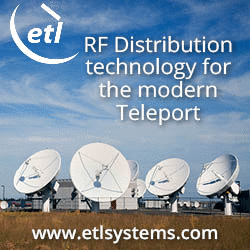|
talksatellite EMEA |
.gif) |
||||||||||||||||||||||||||||
Daily news |
Isotropic Systems and SES Field Test Multi-Orbit Services 2 November 2021
Isotropic Systems and SES announced the
successful completion of the first-ever
simultaneous multi-orbit antenna field tests, a
game-changing development empowering a new age
of connectivity on land, in the air and at sea
for both civil and defense communications.
Isotropic Systems’ UK-built multi-link antenna
underwent a series of field tests at SES’s
Manassas, Virginia teleport. The terminal
established multiple simultaneous,
full-performance link connections with SES
satellites – linking to a geostationary (GEO)
satellite while simultaneously connected with an
O3b satellite in medium earth orbit (MEO).
Currently, users are reliant on legacy ground
antennas which only connect to a single network
at a time. This industry breakthrough enables
satellite end-users to combine the best
attributes of all available networks achieving
superior network uptime and application
performance. Isotropic’s deep tech solution
multiplies the performance of single antenna
solutions to transform the global appeal of
satellite connectivity, ensuring critical
defense communications infrastructure and
delivering multiple broadband connections that
are highly reliable:
·
NATO
and other international forces will finally be
able to converge the most advanced military and
secure commercial satellites, ensuring total
mission assurance around the world.
·
In
the sky, aircraft pilots will be able to connect
to the optimal satellites for navigation and
ground communications, while passengers in the
cabin can connect to entirely separate
satellites in different orbits to access live
television, super-fast broadband, and enhanced
entertainment options with streaming and gaming.
·
On
the ground, the entire land transport sector
will achieve ubiquitous, super-fast, always-on
internet access, allowing people to work as if
they were in the office even if they are riding
on a train or bus, while remote locations can
finally access high-speed broadband.
·
At
sea, ships can be tracked across the oceans,
accelerating digital transformation for the
shipping industry and super-fast internet will
transform the experience for cruise ship
passengers. “We have
removed the major bottleneck holding back the
expansion of the satellite sector for both
commercial and defense communications.
Users can finally connect
to as many satellites as they want, when they
want, wherever they want and that’s a
game-changer for enterprise, aero, maritime,
government and defense,” said John Finney,
founder and CEO of Isotropic Systems. “This test
proves space is now open, as we mesh networks
together in a way that is unparalleled, without
compromise. We have delivered on our vision to
combine the full performance of multiple
antennas into one multi-link, solid state,
software defined terminal without any
restrictions.” “The
success of these multi-orbit antenna trials
opens the door to a new level of multi-orbit
service delivery, as we integrate our
geostationary satellites with our
second-generation low-latency, high-throughput
O3b mPOWER system to provide seamless services
for our customers,” said Steve Collar, CEO of
SES. “Isotropic’s unique architecture enables
our customers to be connected to multiple
simultaneous beams from both GEO and MEO
satellites, enabling us to deliver
industry-defining performance and orbital
resilience services. It is a game changer for
resilient, secure, global networks built on
SES’s state-of-the-art fleet.” Mike
Rudd, Head of Telecommunications Strategy at the
UK Space Agency, said: “This is a significant
breakthrough that will put UK technology
developed by Isotropic Systems at the heart of
meeting the unprecedented demand for global
connectivity. It’s a great example of the
innovation found within the UK’s growing space
sector and has been made possible by our leading
investments in telecommunications research
through the European Space Agency.” |
 |
|||||||||||||||||||||||||||
|
|
|
|||||||||||||||||||||||||||








